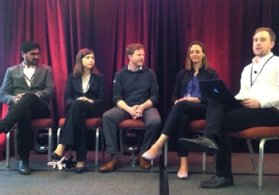
Konstantin Sutyagin - Fotolia
Digital transformation projects will fail without the right culture
Companies that want to experience digital transformation success should focus more on culture and less on technology, according to a panel at the recent Digital Transformation Conference in Boston.
BOSTON -- Enterprise digital transformation projects are only partly about technology. Most of the work is on the people side, and changing an organization's culture is the key to success.
That was the message from a panel of experts at the recent Digital Transformation Conference 2019. The panelists are all involved with digital transformation projects at a variety of enterprises.
The specifics of how digital transformation works varied for each company, but the panelists agreed it generally means having a more nimble organization that can get closer and be more responsive to its customers.
Digital transformation is about changing mindsets
Digital transformation projects should be customer-centric, data-driven and agile, according to Maria Dyshel, digital initiative leader at Sanofi, a Paris-based large pharmaceutical manufacturer undergoing a "massive digital transformation." But she said she believes they also need to take into account employee behavior and how people think.
"We are a massive company across several countries, so our main challenge is how we can inspire our employees to consistently apply all these behaviors and thinking principles in whatever role they have," Dyshel said.
Sanofi's biggest digital transformation challenge isn't the technology, but getting its large workforce to adopt new technologies, making them more accessible and less threatening, Dyshel explained.
"People always feel threatened by technology -- it's new, it's complex, people think that it will displace them. So, removing the threat is the first element," she said. "It's also important to talk to people about technologies like machine learning or AI in plain language, without using any sort of technical language."
Once people understand how the technology works, they're more willing to use it, she said.
Need to get agile
Dyshel wasn't alone in focusing on the people part of digital transformation. Ajay Kapoor, global vice president of digital transformation strategy at consumer appliance company SharkNinja, based in Needham, Mass., also pointed to changing the culture as the hardest part for digital transformation projects.

He recommended companies adopt an "agile mindset" if they want to see project success. More than that, Kapoor said companies will need strong direction and leadership from the top.
"Everyone talks agile, everyone talks about getting things done, but really large businesses have a lot of bureaucracy that they have to cut through," he said. "The biggest struggle for most companies is that it's just easier to continue to do the same thing over and over."
One of the first steps SharkNinja took was to install an executive team that had a clear understanding of the company's mission and roadmap, according to Kapoor.
Trying to avoid disruption
Digital transformation projects tend to fall into two buckets, said Patrick Petitti, co-CEO at Catalant, a Boston-based consulting firm. One bucket is external-facing and enables organizations to connect better and more directly with customers. The other is internal-facing and enables companies to operate better as an organization.
"Companies that we deal with are large organizations going through a digital transformation because they believe that they have to do it quickly, or they will be disrupted," he said.
Traditional organizations do not have the structure to deal with a world focused on speed, agility and customer centricity, but were instead designed for top-down management of employees and accuracy, he said.
However, Petitti cautioned that employees, especially those in large, traditional organizations, won't always accept the changes that digital transformation projects demand. Organizations need to seek out people who are open to doing things differently and hold them up as models for the kind of change they want.
"You can't just roll out large-scale change across a company and expect it to work, as most people struggle with change," Petitti said. "You need to find the places where you can create examples of what successful change looks like and show that the change is actually good for the organization. It's being smart about where you start, finding places where you can be iterative and take chances. Then, point to it and say, 'This team is operating twice as productively as this other team. Don't you want to be in on this, too?'"








